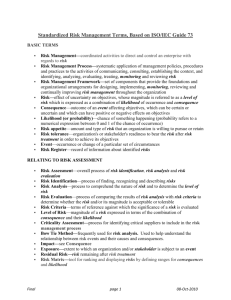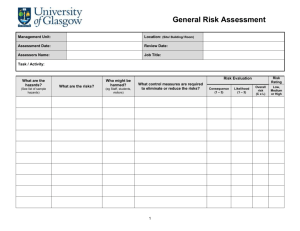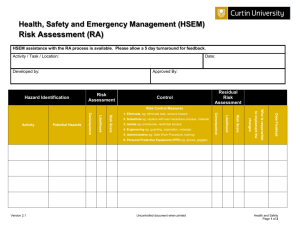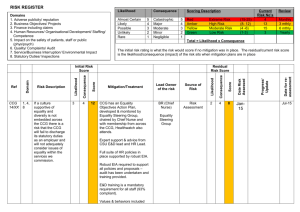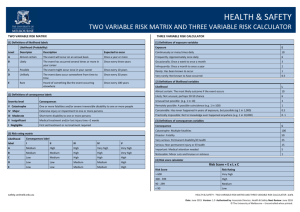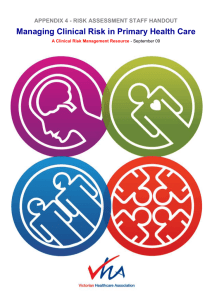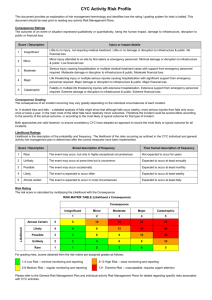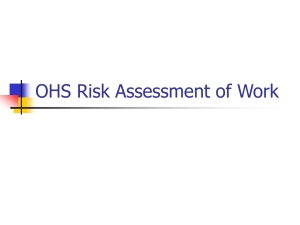Supply Chain Risk Leadership Council -
advertisement
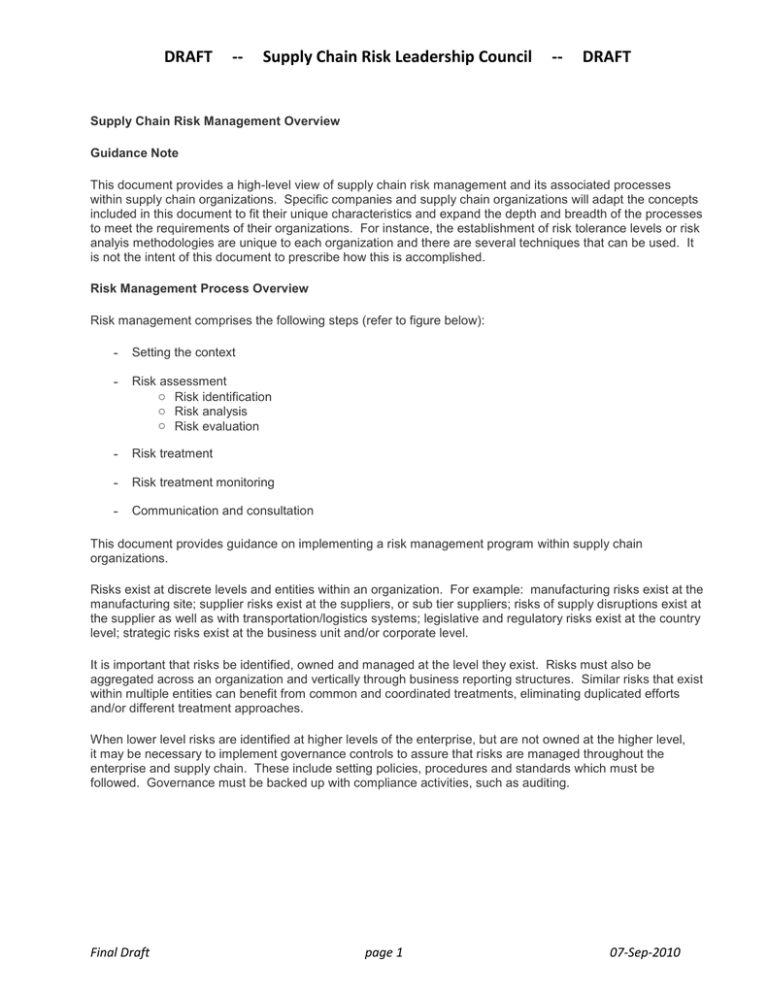
DRAFT -- Supply Chain Risk Leadership Council -- DRAFT Supply Chain Risk Management Overview Guidance Note This document provides a high-level view of supply chain risk management and its associated processes within supply chain organizations. Specific companies and supply chain organizations will adapt the concepts included in this document to fit their unique characteristics and expand the depth and breadth of the processes to meet the requirements of their organizations. For instance, the establishment of risk tolerance levels or risk analyis methodologies are unique to each organization and there are several techniques that can be used. It is not the intent of this document to prescribe how this is accomplished. Risk Management Process Overview Risk management comprises the following steps (refer to figure below): - Setting the context - Risk assessment o Risk identification o Risk analysis o Risk evaluation - Risk treatment - Risk treatment monitoring - Communication and consultation This document provides guidance on implementing a risk management program within supply chain organizations. Risks exist at discrete levels and entities within an organization. For example: manufacturing risks exist at the manufacturing site; supplier risks exist at the suppliers, or sub tier suppliers; risks of supply disruptions exist at the supplier as well as with transportation/logistics systems; legislative and regulatory risks exist at the country level; strategic risks exist at the business unit and/or corporate level. It is important that risks be identified, owned and managed at the level they exist. Risks must also be aggregated across an organization and vertically through business reporting structures. Similar risks that exist within multiple entities can benefit from common and coordinated treatments, eliminating duplicated efforts and/or different treatment approaches. When lower level risks are identified at higher levels of the enterprise, but are not owned at the higher level, it may be necessary to implement governance controls to assure that risks are managed throughout the enterprise and supply chain. These include setting policies, procedures and standards which must be followed. Governance must be backed up with compliance activities, such as auditing. Final Draft page 1 07-Sep-2010 DRAFT -- Supply Chain Risk Leadership Council -- DRAFT Supply Chain Risk Management Process Flow Create Risk Register Document the process and results Document the process and results Risk Assessment Process Identify Risks (team sessions, surveys) Analyze Risks (likelihood, consequence, existing risk treatment actions) Evaluate Risks (compare to risk tolerance or risk appetite, prioritize risks, agree actions) Treat Risks? N Y Document the process and results Identify and Analyze Options Track Implementation Implement Treatment Plans On-Going Monitoring and Review — Quarterly Management Team Meetings and Integrating Risk Discussion into Business Meetings Establish the internal and external risk contexts Analyze and Evaluate Residual Risks Final Draft page 2 07-Sep-2010 DRAFT -- Supply Chain Risk Leadership Council -- DRAFT Set the Context It is important to define the context within which a risk management program is implemented. For supply chain organizations the context comprises those elements that can have an impact on the organization’s supply chain, including suppliers, logistics (e.g., warehousing and distribution), manufacturing, and customers. The scope of these aspects depends on the entity involved: for example, manufacturing plant, assembly or filling operation, and refinery or concentrate plant, business unit or corporate organization. A manufacturing plant must include supplier risk management and manufacturing risk management within its supply chain risk management program. A business unit is also concerned about suppliers and manufacturing, but they do not directly own the risks entailed. Therefore, business units must develop appropriate governance structures to which manufacturing and assembly plants must adhere. However, Business units may own risks associated with legislative and regulatory issues, as well as certain procurement that is centrally coordinated. A key decision in developing and managing a supply chain risk management program is the scope of the supply chain to include. In most cases, the scope should include all tier 1 suppliers and customers. In determining how much of the supply chain to include beyond the first tier, it is helpful to expand the scope based on the specific inputs. Characterize each input according to two factors: number of suppliers and number of customers. For materials where there are a large number of suppliers and customers, it is not necessary to include supply chain elements past tier one in the scope unless the material is particularly critical to operations. For materials with only one supplier where there are only a few customers, the next tier of the supply chain should be included in the study and then conduct a similar assessment for that tier’s suppliers. For materials with a few suppliers where you are the only customer, include at a minimum the highest volume supplier from the next tier of the supply chain in and then conduct a similar assessment for that tier’s suppliers. For materials with a few suppliers and a few customers make a value judgment as to whether that material is critical enough to include the next supply chain tier. By repeating this process for increasing supplier tiers and increasing customer tiers, it is possible to capture the portions of the supply chain that have the greatest risk to operations. Note that this approach is only a guideline, and specific knowledge of an organization and its industry must be used to guide decisions. Map Supply Chain Processes Develop a map(s) or diagram(s) of the organization's supply chain process(es) (see figure below for an example of a partial supply chain map). This step is necessary to understand the potential risks that exist within the scope of the risk management program as well as the organizations involved. Nodes indicate locations where materials are processed, stored or otherwise acted upon. For example, the manufacturing sites on figure B are nodes, as are the warehouses. Links indicate movement of materials or goods, information, and funds between nodes. Information flows should also be documented. Note that information flow can be bi-directional; it can be used to inform upstream processes of downstream conditions so the correct quantity (and quality) of materials can be provided for the processes. As a general rule, organizations should map the supply chain elements for which they are directly responsible and for which they control. Organizations should extend the supply chain map at least one-node-up and onenode-down, taking into consideration direct suppliers and direct customers inclusive of transportation and information links. Final Draft page 3 07-Sep-2010 DRAFT -- Supply Chain Risk Leadership Council -- DRAFT Risk Assessment Process A solid risk management program, from initial deployment to sustainable operation, includes a robust and ongoing risk assessment process. Developing an initial risk register, which is a one-time effort, is necessary to form the baseline risks. An on-going risk assessment process is then implemented to periodically review the status of risks in the risk register as well as to incorporate new risks and eliminate risks that are no longer relevant. The steps listed in the following sections serve as a guide. It is important to distinguish between risks that should be included in the risk management process and those that should not. Normal variations in product demand or product quality, and that are maintained within acceptable limits, are not risks that need to be included. However, an abnormal variation, one for which the supply chain cannot flex and respond to, is one that should be included. Final Draft page 4 07-Sep-2010 DRAFT -- Supply Chain Risk Leadership Council -- DRAFT Construct Initial Risk Register Construct initial risk register for the mapped processes. The initial risk register will likely not cover all risks, nor even all significant risks. It is a starting point to identify, analyze and begin to treat relevant risks facing the supply chain organization. Over time, additional risks will be added to the risk register, and some may be eliminated. Risk Identification Identify and list potential risk events within the supply chain processes (use brainstorming sessions, previous risk assessments, surveys, etc). See Risk Management Tools - Extract from BS 31100, Code of Practice for Risk Management or ISO 31010:2009 Risk management – Risk assessment techniques for examples of alternative methodologies for identifying risks. For a comprehensive list of potential risks that can be used to construct a survey, the results of which could form the basis of the initial risk register, see the accompanying list of risk categories and risks. Risk Analysis Estimate risk likelihood and consequence Rank the identified risk events using a simple single risk rating based on a qualitative overall risk level. This simplistic approach should only be used for the initial risk register, and provides an easy way to quickly prioritize perceived risks and select those that will form the initial risk register. Select the top tier of risk events using an agreed criteria, such as the top 25-percent (retain the remaining risks for future consideration) or the top 30 risks. Analyze the top tier risk events using an agreed methodology, such as the bow-tie method: o rate the likelihood and consequence of the risk event in the absence of any treatment (native or inherent risk) o rate the likelihood and consequence of the risk event taking into account existing risk treatment (residual risk) As an example, assume a risk event described as “the loss of manufacturing capability at facility ABC-123.” There are a number of potential causes, such as an earthquake, a fire, a flood, failure of a key supplier, or the temporary loss of most workers due to an infectious disease outbreak. Each of the potential causes is assigned a likelihood of occurrence, without consideration of any treatment to reduce that likelihood. As it stands, this facility manufactures subassemblies that form the basis for 50-percent of the organization’s production Likewise, the potential consequences are assigned a rating reflective of the magnitude of the consequence, in this case, relating to the amount of production that will be lost and for what time period. They are then linked to the enterprise's strategic goals such as revenue. The scales used for likelihood and consequence will be dependent upon, and unique to, the individual organization. For example, a 5-point scale could be used for both likelihood and consequence. The likelihood scale could range from less than 5-percent for the least probable and over 90-percent for the most probable. The consequence scale could range from less than 2percent of gross revenue or less than 4-percent of net revenue for the lowest category, up to over 20-percent of gross revenue or over 40-percent of net revenue for the highest consequence category. Revenue consequence is just one example that may be used. The risk level before any risk treatment is calculated by combining the likelihood and consequence ratings. The method of combining the ratings can be as simple as a straight addition or Final Draft page 5 07-Sep-2010 DRAFT -- Supply Chain Risk Leadership Council -- DRAFT multiplication. An important point is to not lose view of the high-consequence but lower likelihood risk events. This can be done through a plot of the enterprise's risk acceptability frontier or a matrix of likelihood and consequence categories. The risk level is then calculated by combining the likelihood and consequence ratings following any treatment to reduce these. These post-treatment risk levels are referred to as “residual risk.” Risk Evaluation Evaluate the residual risk level against acceptable risk level (risk tolerance). The acceptable risk level is unique to each organization and supply chain, and may vary over time. An organization may determine that any individual risk level representing a loss exposure greater than 5-percent of net income with a likelihood greater than 50-percent is not acceptable and must be treated to modify the risk level. The organization may also consider an aggregated loss exposure (all risks taken together) greater than 10-percent of net income with a likelihood greater than 50-percent as not acceptable. Different risk tolerance levels may be set for different levels of the organization, such as at the business unit level, country level, etc., and may not always be tied directly to revenue. On-Going Risk Assessment Emerging Risks Develop a mechanism or mechanisms to detect emerging risks and risk events. The output of these mechanisms provide an input to the on-going risk identification processes within an organization. Engage with suppliers, customers, and other supply chain partners to identify emerging risks Actively use customer complaint data as an indicator of supply chain problems Engage with industry trade associations to provide information Use employee knowledge and observations Periodic Risk Reviews (quarterly) Conduct periodic (e.g., annually, biannually, quarterly) reviews of the risks in the risk register to: Determine if the likelihood and/or consequence levels have changed (and thus the risk level) Ensure agreed risk treatment actions have been implemented or are on track and within available budget/resources Incorporate new or emerging risks into the risk register when appropriate The period between risk reviews will depend on the nature of the organization and its supply chain. If the business or the environment in which it operates is dynamic, more frequent reviews would be suggested. Quarterly risk reviews is a reasonable starting frequency. Experience will determine the optimum period for these reviews. Event Triggered Reviews Any time there is a change in the basic configuration of operations, a risk assessment should be conducted at a minimum on the portion(s) that have been altered. Changes that can trigger this review include changes in suppliers (additions, removals, or shifted share), changes in processes or equipment, and new products. Likewise, an assessment should be conducted after a risk event occurs to assess the effectiveness of the response actions as well as the accuracy of the risk assessment procedures. Final Draft page 6 07-Sep-2010 DRAFT -- Supply Chain Risk Leadership Council -- DRAFT Risk Treatment Risk Treatment Actions If the residual risk is above acceptable levels, determine additional treatment methods to: o Reduce the likelihood that the risk event will occur o Reduce the consequence of the risk event if it occurs Ensure the new residual risk is within the acceptable range Document the steps required to implement the additional treatments defined, acquire the resources to implement, assign a responsible person for each, and ensure follow-up until the treatment is in place Note that risk treatment actions can include avoiding the risk or transferring the risk (eg via insurance or contractually). Common Supply Chain Risk Treatment Actions Due to the structure and function of supply chains, several well-entrenched techniques are used to treat risks common to all supply chains. The most important of these risks is that of a supply chain disruption, for which business continuity planning and preparedness programs are used to reduce the likelihood and/or the consequence of a supply chain disruption. Results of the risk assessment highlight specific risks that must be treated. The following briefly discusses major categories of risk treatment commonly used in supply chains. Business Continuity Planning and Preparedness Supply chain risk assessments will uncover situations (risk events) that could result in the disruption of some part of the supply chain. The risk of a supply chain disruption is of such concern, and can be caused by so many different events, that it has become a discipline in itself. It is important that risks identified during risk assessment processes be reflected in business continuity plans. Several more specific risk treatment actions are subsets of business continuity planning and preparedness: Incident Detection Processes When a risk event is identified, including the causes, it is useful to determine if triggers exist that could provide early indication that the risk event is about to occur. The sooner that actions can be taken to limit the magnitude of the consequences and duration of the risk event, the sooner the organization can recover from the risk event. This in turn increases the resiliency of the organization’s supply chain. Emergency Planning and Response In addition to the legal requirements for emergency action and response plans (EPA, OSHA), an organization’s supply chain will benefit from creating plans to deal with reasonably foreseeable risk events, such as fires, hazardous materials spills, or workplace accidents. By knowing in advance how to deal with a specific emergency situation, the duration and hence the magnitude of the consequences can be limited and the resilience of the organization is improved. Crisis Management Planning All emergency situations are not able to be contained as well as organizations would like. If a situation is not handled well, or for reasons outside an organization’s control, some events become public and well-covered in the media. In these situations it is important to have well-developed processes to Final Draft page 7 07-Sep-2010 DRAFT -- Supply Chain Risk Leadership Council -- DRAFT handle the flow of communications and activities in order to limit the damage that could occur to an enterprise’s reputation or threaten its existence. Recovery Planning Recovery planning is also an important component of business continuity plans. After the risk event has occurred and is over, the task turns to recovering from the aftermath of the risk event. The components of a solid supply chain risk management program are designed to limit the magnitude and duration of consequence, yet it is unlikely that all consequences can be avoided. Recovery planning considers reasonable foreseeable loss events and develops alternative arrangements that can be implemented to limit the consequence of any single loss. Examples include alternative transportation routes, backup manufacturing capacity, and alternative suppliers. Design for Resiliency It is possible to enhance the resiliency of supply chains by considering the design of products, and selection of subcomponents and suppliers as well as structure, characteristics and limitations of the supply chain during product and/or service design. Aspects such as materials, manufacturing processes, transportation and logistics can be incorporated into designs to optimize the likelihood and consequence of risks. Supply Chain Security Programs Security within supply chains is a critical aspect of overall supply chain resiliency. Theft, or intentional contamination of, or damage to, materials and products can disrupt an organization’s operations and may even result in damage to reputation and resulting loss in market share. Compliance Programs (Legal and Regulatory) Organizations are governed by many laws and regulations designed to ensure consistency in financial reporting, treatment of employees, protection of the environment, safeguarding the public and society, and adhering to specific business practices covering areas like competition. Risks of non-compliance with these many laws is real and must be actively managed by organizations, including supply chains. Monitor Risk Treatment Effectiveness Develop methods to monitor the effectiveness of risk treatment actions implemented to reduce risks to acceptable levels. This is an important step to continuously identify and assess risks. Key points in risk treatment effectiveness monitoring: The greater the difference between the untreated and treated risk levels, the more important it is to monitor the effectiveness of risk treatment If management programs are used to treat risks, the usual monitoring consists of auditing against implementation of those programs If manufacturing controls are implemented to treat quality risks, some measure of deviation from specifications is a measure of risk treatment effectiveness If analyses of incoming parts or ingredients are used to treat supplier performance risks (e.g., quality, delivery, cost), the results of those analyses are an indicator of the risk treatment effectiveness. Final Draft page 8 07-Sep-2010
